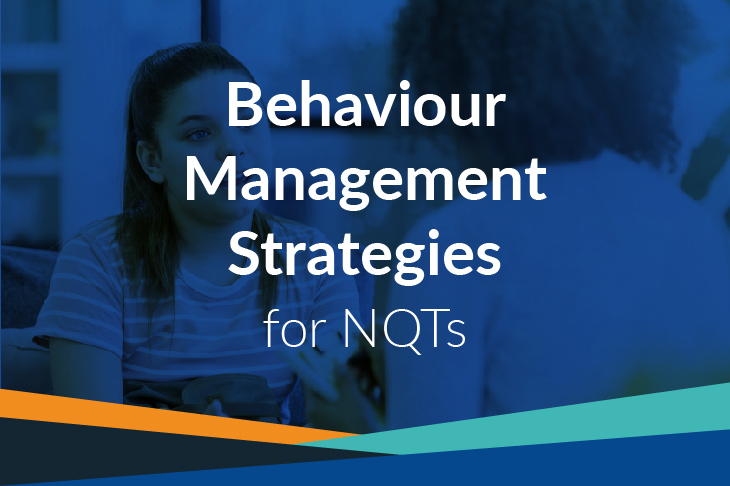Behaviour Management Strategies for NQTs

Managing behaviour in the classroom can be as challenging for experienced teachers as it is for newly qualified teachers (NQTs). Effective behaviour management sets the foundations for success in the classroom, ensuring positive learning outcomes for students. However, disruptive behaviour can take up a lot of your time, negatively impacting on the rest of the class, so it is essential to deal with it early on.
There are several reasons why a student might misbehave – they may be struggling with the work, bored in the classroom or reacting to environmental influences. Forms of unwanted behaviour can range from attention-seeking and making unwanted noise, to swearing and aggression – all of which are disruptive in the classroom environment. However, there are many ways that you can manage and prevent it. Here are some of our favourite behaviour management strategies to try as an NQT:
Establish ground rules

It is essential to lay down some basic ground rules to set boundaries for your students at the start of the school year. The rules should be simple and easy to follow. If you are using this as one of your behaviour management strategies, you then need to be consistent in your approach throughout the year to set clear boundaries and expectations in your classroom. Consistency will reinforce your ground rules and teach your students structure, routine and what to expect in your classroom.
Your basic ground rules could include:
- Always say please and thank you
- Be kind and polite to each other
- Listen to each other
- Put your hand up if you have something to say
- Tidy up after yourself
- Keep your voice at a low volume
- Be prepared – bring your supplies and homework to class
- Work hard and always try your best
- Respect each other, your teachers and personal belongings
- Be on time in the morning and after breaks
Use body language

Nonverbal communication is a powerful tool. Our body language and facial expressions convey more messages than our speech and tone of voice. Therefore, body language can be used as a valuable method of managing behaviour in the classroom.
Teachers should aim to make themselves approachable and friendly through their nonverbal communication, while avoiding body language that might be perceived as threatening. Here are a few tips that you can try:
- Maintain an open stance to show confidence, authority and leadership. An open posture makes you more approachable and friendly, whereas closed body language (such as folded arms) can come across as angry or confrontational
- Smiling is a great way of sharing positive energy with your class. A happy and relaxed facial expression makes people feel at ease. A smile is welcoming and friendly, making you even more approachable to your students
- Moving around the classroom keeps all students involved, making your class inclusive and your lessons dynamic. You can keep an eye on what’s going on around your classroom and show that you’re an authority figure, whilst helping to engage inattentive children and spot those who might be struggling
- Use eye contact and a steady gaze to show that you are interested in your students and confident in leading them. Good eye contact will help to develop trust and communication, but too much eye contact might be intimidating, so you need to find a middle ground
- Avoid crossing your arms, frowning and raising your voice, as this might make you appear angry, confrontational and hostile to your class. Be sure to stick to your own class rules and keep cool, calm and collected! You should model the behaviours you want to see from your class
- Use non-verbal cues, such as finger to lips to signal ‘quiet’, thumbs up to recognise good work, or pointing to signal that a child should sit down. These gestures can be used effectively to direct students towards the desired activity.
Reward and reprimand

Its widely acknowledged that children will repeat behaviours they’re rewarded for. Therefore, it makes sense to reward them for positive behaviours such as completing work on time, saying please and thank you, and raising their hand in class. Rewarding positive behaviour is a good motivator, and rewards can be small and simple, such as stickers on a reward chart or opportunities to be a ‘helper’ during a lesson. Other children will follow suit when they see good behaviour being rewarded. It is also important to build positive relationships with your class. Positive encouragement allows you to be proactive in your approach to behaviour management through the promotion of positive behaviours and skills.
Meanwhile, children are less likely to repeat behaviours that are reprimanded and therefore, these behaviours should be sanctioned. As part of your class rules, you should clarify the sanctions that can be expected for negative and unwanted behaviours, in line with your school policies. For example, detention, a verbal warning or removal from the classroom can act as a strong deterrent for disruptive behaviour, but consistency is crucial. You must apply the same rules to all the children in your classroom to ensure fairness and to reinforce your approach. When reprimanding a child, you should never do it in front of their peers. Instead, you should do it in a one-to-one situation to avoid feelings of humiliation for the child.
Introduce a countdown routine

In a primary school setting, initiating a countdown can be one of the most effective behaviour management strategies. When a class is disruptive, you can start a countdown to give students time to consider how they are behaving, which can stop unwanted behaviour in its tracks. The countdown gives students a chance to end their disruptive behaviour and helps to re-establish your classroom status quo. It gives a gentle warning that behaviour is unacceptable and helps children to acknowledge this in their own time and avoid being reprimanded.
You can link this method with your reward and reprimand approach. Your class should know that at the end of the countdown, you will implement sanctions, while those who assist and join in with the countdown will be praised for reinforcing the rule.
Use CASPER
You can use the CASPER approach to behaviour management as an effective tool to remind you of the key steps to take when dealing with unwanted behaviour:
Calm – you should aim to appear calm on the outside,
even if you’re not feeling calm inside. Taking deep breaths and counting to ten
in your head can help to ground you and give you space to think clearly in a
challenging situation
Assertive – during challenging situations when you’re dealing with
disruptive behaviour, you must remember that you are the authority figure in
the classroom and you are in charge of the situation. Use your body language,
tone of voice and eye contact to reinforce this message
Status preservation – it is important to reprimand a child in private
rather than in front of their peers. Reprimanding a child in front of their
classmates can cause feelings of embarrassment and humiliation, and it is
important not to affect their self-esteem by reprimanding in front of their
peers
Empathy – you should try to understand how the child is feeling and what
might be causing their unwanted behaviour. If they are emotional, you should
avoid asking challenging questions and try to show empathy and understanding
instead
Respect – as a Teacher, you are a role model figure to your class. This is
a privileged position that enables you to model desired behaviours to reinforce
your expectations for good behaviour. Therefore, you must demonstrate that you
respect the children in your class too.
There are numerous behaviour management strategies and tips available to help NQTs with positive behaviour management in the classroom. At New Directions, we offer Team Teach training to equip you with the skills to de-escalate situations and manage challenging behaviour.
Find out more by contacting your ND Education Account Manager or register with ND Education today to access specialist training for Teachers.
‹ Previous articleNext article ›